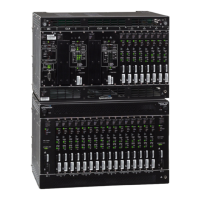1
097-55501-01 Issue 6 – June 2003 145
2
5
3
Operational Verification & Configuration
13 Set the priority if desired. The priority setting provides a way to prefer one of the CC inputs
when both have been qualified. The lower the number, the higher the priority. The default
is that the CC1 has higher priority than CC2, so CC1 will always be used if it is qualified.
To change priority if using TimeScan THC:
Use the Priority row on the Configuration -> Input screen to change the priority of either
CC1 or CC2 as desired.
To change priority if using terminal software, such as HyperTerminal, the TL1 general form
for priority setting is:
ED-SYNC::CLK-a:SV380:::PRIORITY=b;
Where a = 10 or 11 (10 = CC1, 11 = CC2) and b = 0 - 12 to set the actual priority value.
To set CC2 priority to 3, type and send:
ED-SYNC::CLK-11:SV380:::PRIORITY=3;
Priority setting for CC2 can be retrieved with:
RTRV-SYNC::CLK-11:SV381:::PARAMETER=PRIORITY;
14 If the shelf will normally operate with a single clock card, the SNGLCK keyword can be
used to disable the alarm that is usually associated with this mode of operation. See the
TimeHub 5500 TL1 Reference Manual for more information about the SNGLCK keyword.
Provision outputs
15 There are three basic steps to provisioning an output:
1. Putting the output card group that supplies that output in service.
2. Selecting the framing for the output, if appropriate.
3. Enabling the specific output port so that a signal will be produced on that port.
For a given port to actually generate output, that port must be enabled AND the card group
that contains that port (i.e., A, B, C, or D for master shelf) must be put in service.
Procedure 4-9. System Configuration (Cont’d)
Step Action

